The wonga pigeon is an elusive breed native to Eastern Australia.
It is recognizable for its plump body, distinctive coloring and call that gives it its name.
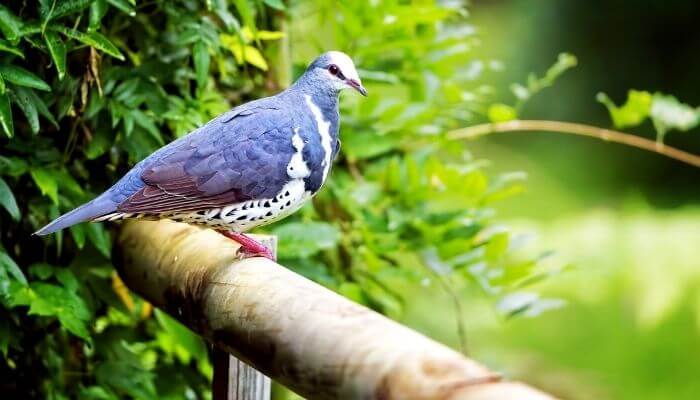
Origins of the Wonga Pigeon
The wonga pigeon, Latin name Leucosarcia Melanoleuca, originates from Australia.
The breed’s interesting name comes from the indigenous (Aboriginal) people of Australia.
The original name for the bird was slightly longer, ‘wonga-wonga’, and this name – like that of so many birds (like the mourning dove, for example) was inspired by the sound of their call.
Distribution And Habitat of the Wonga Pigeon
In previous generations, wonga pigeons could be found across Australia as far north as Cairns and as far south as the Dandenong Mountains, but this range has decreased over time.
As of 2022, wonga pigeons are very rarely seen in the far north and south regions, but it doesn’t seem to have affected their overall population because the numbers are better than ever even with the smaller range of movement.
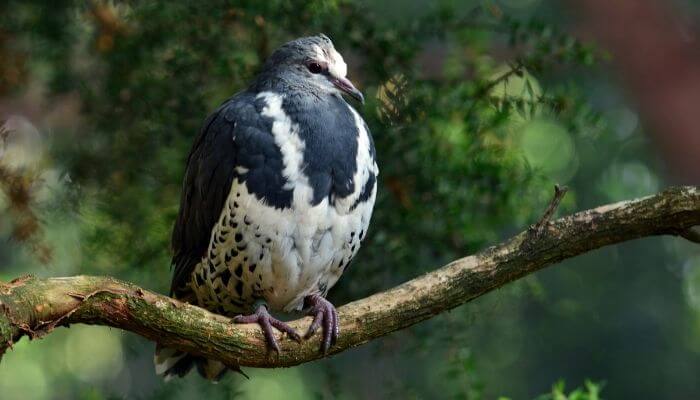
Most of the population is from Central Queensland to Gippsland in Eastern Victoria, although considering the size of Australia, this is still a major range.
The decrease in range is due to a number of different factors including mass land clearance in the country, crop protection shootings that were particularly prevalent in the 1940s, and fox predation.
Their preferred habitat is temperate and sub-tropical rainforests, wet sclerophyll forests and other eucalypt forests with thick understorey.
Wonga Pigeon Conservation Status
Although the extent of their range may have decreased, the risks factors that previously threatened these birds have all but disappeared and with a growing population, the wonga is classed as of “Least Concern” on the conservation spectrum.
Appearance of the Wonga Pigeon
| Wingspan | Length | Weight | Coloring | |
|---|---|---|---|---|
| Wonga pigeon | 65 – 75 cm | 38 – 45 cm | 330 – 500 g | Deep blue/grey with specific white markings |
| Average Feral Pigeon | 64 – 72 cm | 32 – 37 cm | 300 – 500 g | Bluish grey with some black |
The wonga pigeon is a large, plump kind of pigeon that boasts a short neck, broad wings and a longer than usual tail.
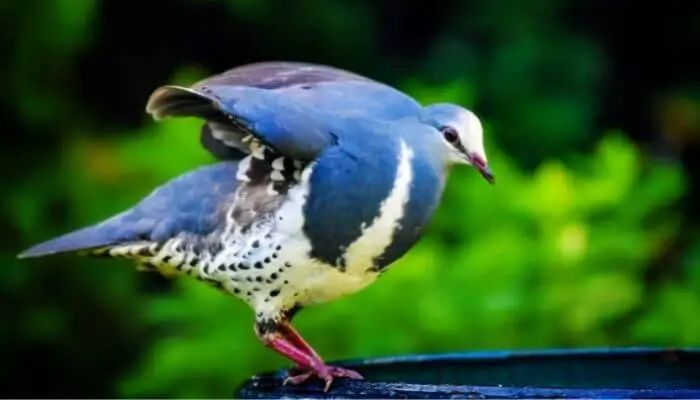
On average, the length of the bird can vary from 38 cm to 40 cm.
The coloring is quite distinctive.
Although the colors are the typical blue/grey and white of the common feral pigeon and wood pigeon, their configuration gives them a completely different visual appearance.
The feathers of a wonga pigeon are blue-grey on their back, and the head fades to a creamy off-white color.
The underside of the bird is white with unique dotted darker grey spots that display a V sign on the chest. It almost appears if the bird is wearing a white scarf.
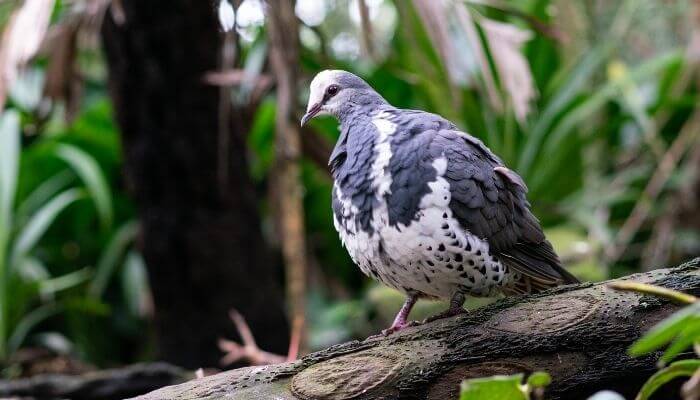
A wonga pigeon’s eyes are a dark red-brown color, and the rings that encircle the eyes are a striking pink. The wonga’s bill, feet and legs are deep pink to red.
When it comes to differences between the sexes, mature males and females appear to be identical. Immature pigeons, however, tend to be browner in body, with a less distinct and visible V pattern in their feathers.
Character of the Wonga Pigeon
One of the most notable characteristics of the wonga pigeon is that they are incredibly elusive, perhaps one of the main reasons for their enviable ‘Least Concern’ conservation status!
You are much more likely to hear a wonga pigeon than actually see one, and they produce a distinct wing clap when they scarper after being disturbed.
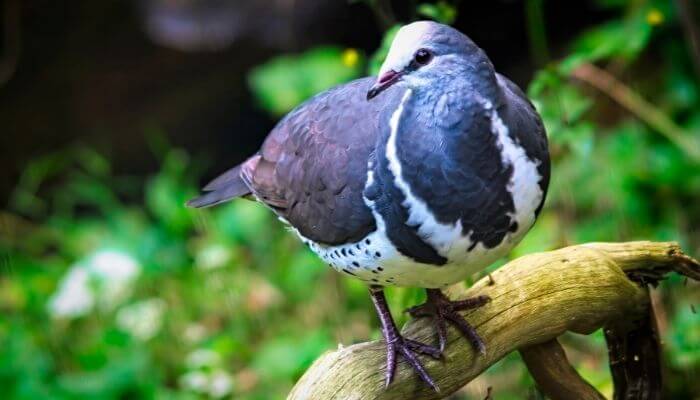
If you do see them, they are most often alone or in pairs because they are solitary animals and widely disperse themselves within forested areas.
The other distinctive characteristic of the wonga pigeon is its vocalization.
We already know that their name originates from the native Aboriginals attributing their language to the sound, but in general, the wonga pigeon’s call sounds like a loud ‘woop woop’, but we think that the Aboriginal translation of wonga-wonga is much more lyrical and fun to say!
Calls can be heard up to 2km away and the bird can sing for hours on end.
During mating season when males are ‘displaying’, they perform bows alongside a softer, trilling coo.
Diet of the Wonga Pigeon
The eating habits of a wonga pigeon are that of a ground forager.
As well as rainforests, wonga pigeons can happily feast on the floors of wet eucalypt forests, picnic areas, coastal forests, car parks, gardens and walking tracks.
All, we might add, when they are deserted and free of human interference!
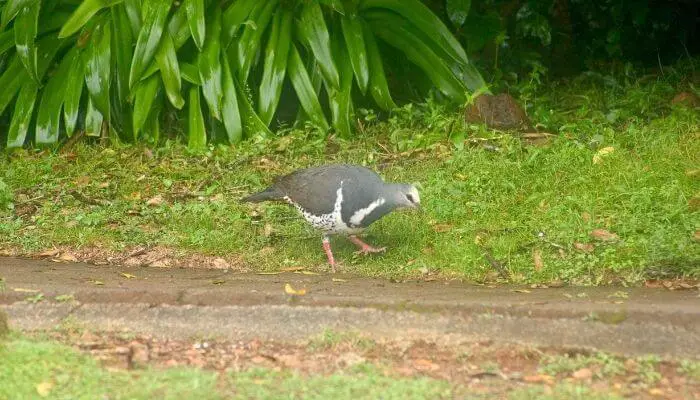
They mainly feed in the early morning and late afternoon and will often walk long distances along well-defined routes.
They actually follow the same path every time to a feeding site.
When there is an abundant food source, it’s usually the only time you will see wonga pigeons gathered in numbers, dispersing after they have eaten.
The diet of the wonga pigeon can be described as opportunistic given their status as a wild bird, but in general, they will regularly eat things such as fruit, seeds from native forest trees and berries.
They are particularly fond of Acacia and Bleeding Heart berries.
Wonga pigeons also eat more invertebrates (cockroaches, snails and caterpillars) than other pigeon breeds.
Wonga Pigeon Mating and Breeding
The wonga pigeon is a monogamous bird, and its breeding seasons occur between the months of October and January.
It builds a saucer-shaped twig and vine platform nest that usually has a diameter of around 30 cm and can sit anywhere from 3 to 20 meters above the ground surface in a tree fork.
This nest will be fiercely defended by the breeding pair.
They will bow and click, charging directly toward the intruder.
On rare occasions, wonga pigeons will also choose to use the abandoned nests of other birds like tawny frogmouths and topknot pigeons.
They have a very alert posture while roosting on eggs.
The bird will keep its patterned tail raised high, facing any potential observers while also peering over the tail to watch for potential threats.
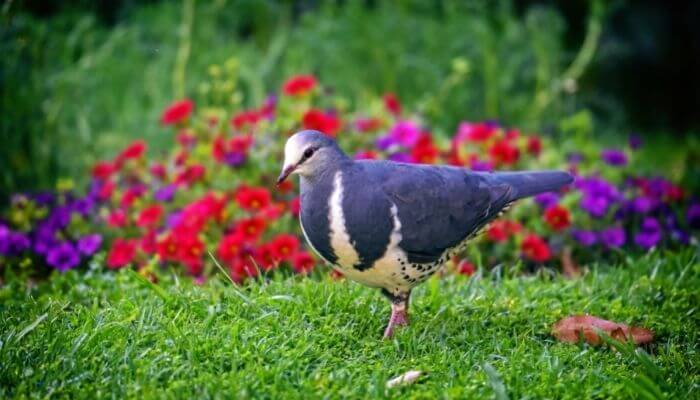
The normal brood size for a mating couple tends to be two eggs that are up to 4 cm long in size.
Like most pigeons, both parents take care of the chicks, feeding them by regurgitation, both producing crop milk.
Young birds tend to stay with their parents for some time although will become responsible for feeding themselves.
Care Of Wonga Pigeons
Being wild, elusive birds, there aren’t really any particular rules of care to follow for keeping a wonga pigeon.
There is always the ethical question of whether you should keep a wild pigeon as a pet.
As respectful bird enthusiasts, however, we should try to preserve the natural habitats that we know they like to frequent and where they feed.
When we can protect their natural habitats, the species can continue to flourish!
